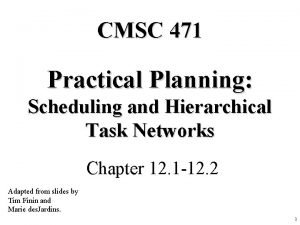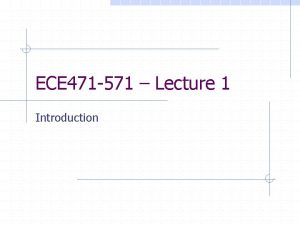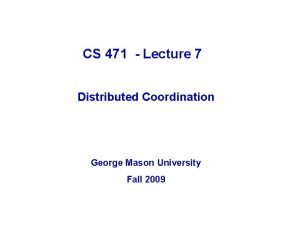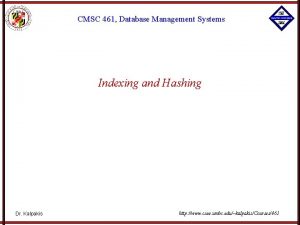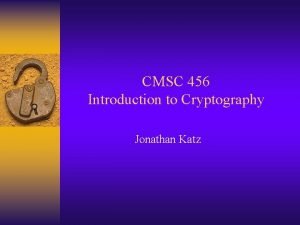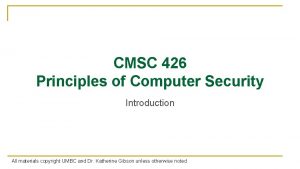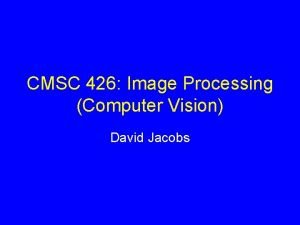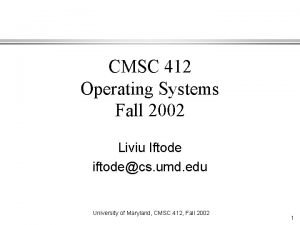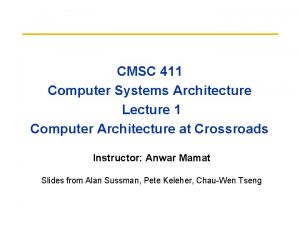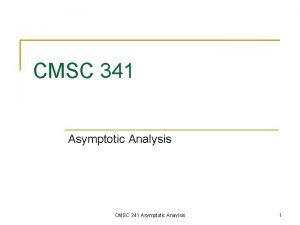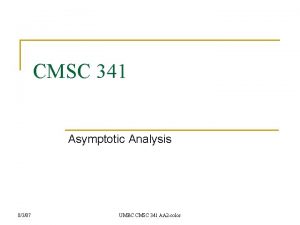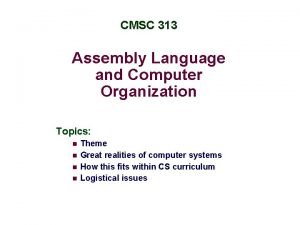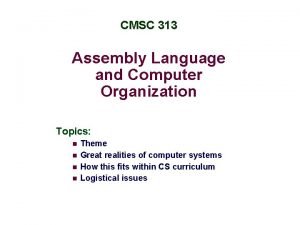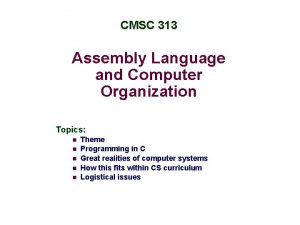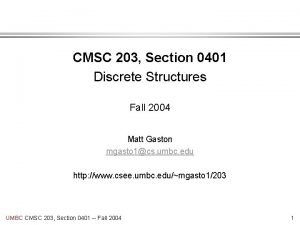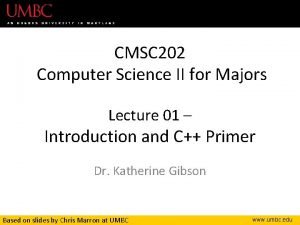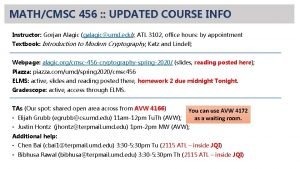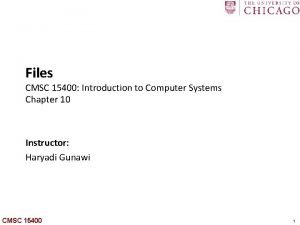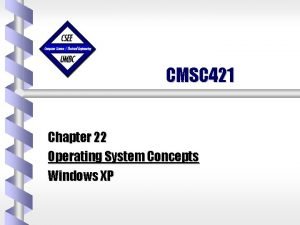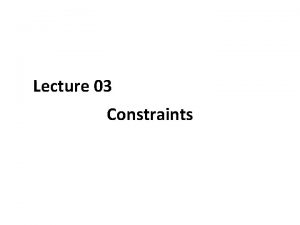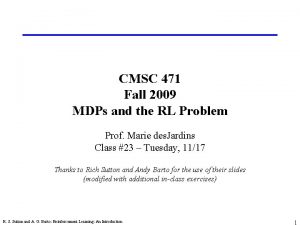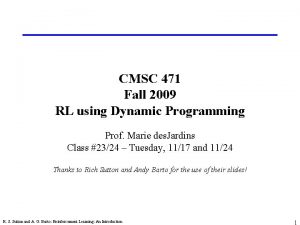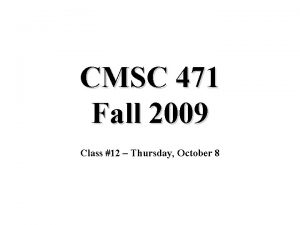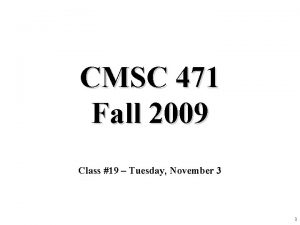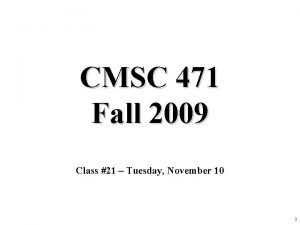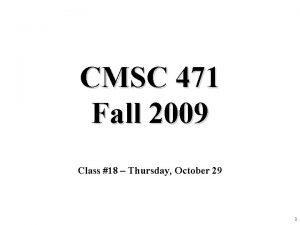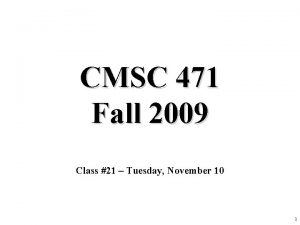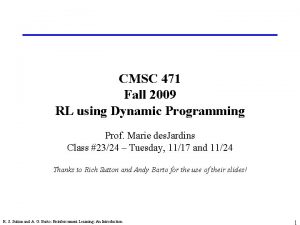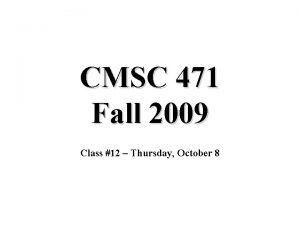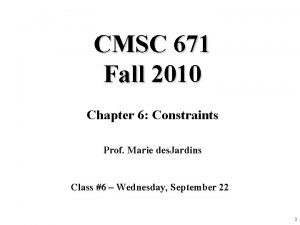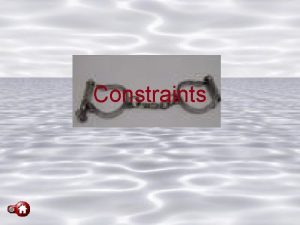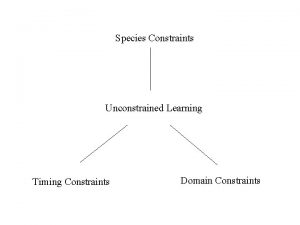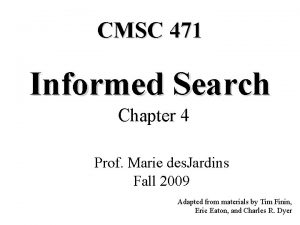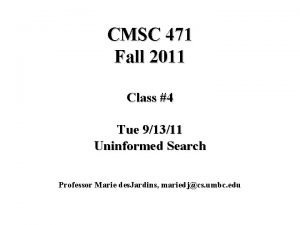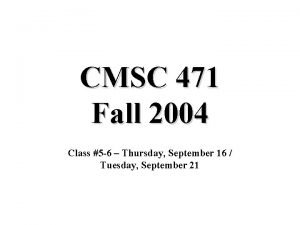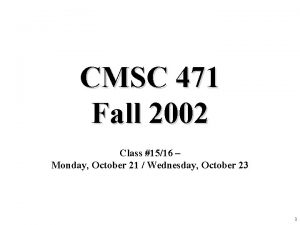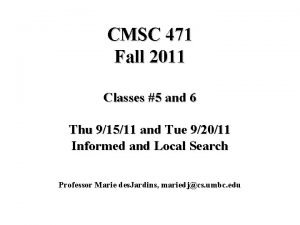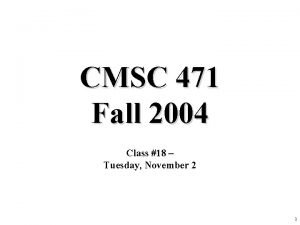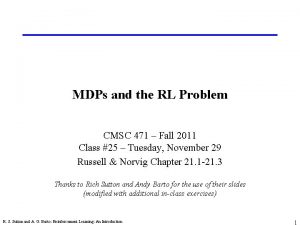CMSC 471 Fall 2009 Chapter 5 Constraints Prof






































- Slides: 38

CMSC 471 Fall 2009 Chapter 5: Constraints Prof. Marie des. Jardins Class #7 – Tuesday, September 22 1

On Lisp • “Tell your students they'll learn to love it, I did. ” – Mike Pickens ’ 03 (CMSC 471 student, Fall 2002) 2

Today’s class • Constraint Processing / Constraint Satisfaction Problem (CSP) paradigm • Algorithms for CSPs – Backtracking (systematic search) – Constraint propagation (k-consistency) – Variable and value ordering heuristics – Intelligent backtracking 3

Constraint Satisfaction Russell & Norvig Ch. 5. 2 -5. 3 4

Overview • Constraint satisfaction offers a powerful problem-solving paradigm – View a problem as a set of variables to which we have to assign values that satisfy a number of problem-specific constraints. – Constraint programming, constraint satisfaction problems (CSPs), constraint logic programming… • Algorithms for CSPs – – Backtracking (systematic search) Constraint propagation (k-consistency) Variable and value ordering heuristics Backjumping and dependency-directed backtracking 5

Informal definition of CSP • CSP = Constraint Satisfaction Problem • Given (1) a finite set of variables (2) each with a domain of possible values (often finite) (3) a set of constraints that limit the values the variables can take on • A solution is an assignment of a value to each variable such that the constraints are all satisfied. • Tasks might be to decide if a solution exists, to find a solution, to find all solutions, or to find the “best solution” according to some metric (objective function). 6

Informal example: Map coloring • Color the following map using three colors (red, green, blue) such that no two adjacent regions have the same color. E D A B C 7

Map coloring II • • Variables: A, B, C, D, E all of domain RGB Domains: RGB = {red, green, blue} Constraints: A B, A C, A E, A D, B C, C D, D E One solution: A=red, B=green, C=blue, D=green, E=blue E D E A C B => D A C B 8

Example: SATisfiability • Given a set of propositions containing variables, find an assignment of the variables to {false, true} that satisfies them. • For example, the clauses: – (A B C) ( A D) – (equivalent to (C A) (B D A) are satisfied by A = false B = true C = false D = false 9

Real-world problems • • • Scheduling Temporal reasoning Building design Planning Optimization/satisfaction Vision • Graph layout • Network management • Natural language processing • Molecular biology / genomics • VLSI design 10

Formal definition of a constraint network (CN) A constraint network (CN) consists of • a set of variables X = {x 1, x 2, … xn} – each with an associated domain of values {d 1, d 2, … dn}. – the domains are typically finite • a set of constraints {c 1, c 2 … cm} where – each constraint defines a predicate which is a relation over a particular subset of X. – e. g. , Ci involves variables {Xi 1, Xi 2, … Xik} and defines the relation Ri Di 1 x Di 2 x … Dik • Unary constraint: only involves one variable • Binary constraint: only involves two variables 11

Formal definition of a CN (cont. ) • Instantiations – An instantiation of a subset of variables S is an assignment of a value in its domain to each variable in S – An instantiation is legal iff it does not violate any constraints. • A solution is an instantiation of all of the variables in the network. 12

Typical tasks for CSP • Solutions: – Does a solution exist? – Find one solution – Find all solutions – Given a partial instantiation, do any of the above • Transform the CN into an equivalent CN that is easier to solve. 13

Binary CSP • A binary CSP is a CSP in which all of the constraints are binary or unary. • Any non-binary CSP can be converted into a binary CSP by introducing additional variables. • A binary CSP can be represented as a constraint graph, which has a node for each variable and an arc between two nodes if and only there is a constraint involving the two variables. – Unary constraint appears as a self-referential arc 14

Example: Crossword puzzle 1 2 3 4 5 15

Running example: XWORD puzzle • Variables and their domains – – – X 1 is 1 across X 2 is 2 down X 3 is 3 down X 4 is 4 across X 5 is 5 across D 1 is 5 -letter words D 2 is 4 -letter words D 3 is 3 -letter words D 4 is 4 -letter words D 5 is 2 -letter words • Constraints (implicit/intensional) – – – C 12 is “the 3 rd letter of X 1 must equal the 1 st letter of X 2” C 13 is “the 5 th letter of X 1 must equal the 1 st letter of X 3” C 24 is … C 25 is … C 34 is. . . 16

1 2 4 3 Variables: X 1 X 2 X 3 X 4 X 1 X 2 X 3 5 X 4 Domains: Constraints D 1 = {astar, happy, hello, hoses} (explicit/extensional): D 2 = {live, load, peal, peel, save, talk} C 12 = {(astar, talk), D 3 = {ant, oak, old} (happy, peal), D 4 = {live, load, peal, peel, save, talk} (happy, peel), (hello, live) …} C 13 =. . . 17

Solving constraint problems • Systematic search – Generate and test – Backtracking • Constraint propagation (consistency) • Variable ordering heuristics • Value ordering heuristics • Backjumping and dependency-directed backtracking 18

Generate and test: XWORD • Try each possible combination until you find one that works: – – astar – live – ant – live astar – live – ant – load astar – live – ant – peal … • Doesn’t check constraints until all variables have been instantiated • Very inefficient way to explore the space of possibilities (4*6*3*6 = 432 for this trivial problem, most illegal) 19

Systematic search: Backtracking (a. k. a. depth-first search!) • Consider the variables in some order • Pick an unassigned variable and give it a provisional value such that it is consistent with all of the constraints • If no such assignment can be made, we’ve reached a dead end and need to backtrack to the previous variable • Continue this process until a solution is found or we backtrack to the initial variable and have exhausted all possible values 20

Backtracking: XWORD 1 a s 4 2 t a 3 r u a n l 5 k X 1=astar X 1=happy X 2=live X 2=load X 3=ant … X 2=live … X 2=talk X 3=oak X 3=old 21

Problems with backtracking • Thrashing: keep repeating the same failed variable assignments – Consistency checking can help – Intelligent backtracking schemes can also help • Inefficiency: can explore areas of the search space that aren’t likely to succeed – Variable ordering can help 22

Consistency • Node consistency – A node X is node-consistent if every value in the domain of X is consistent with X’s unary constraints – A graph is node-consistent if all nodes are node-consistent • Arc consistency – An arc (X, Y) is arc-consistent if, for every value x of X, there is a value y for Y that satisfies the constraint represented by the arc. – A graph is arc-consistent if all arcs are arc-consistent. • To create arc consistency, we perform constraint propagation: that is, we repeatedly reduce the domain of each variable to be consistent with its arcs 23

Constraint propagation: XWORD example 1 2 3 4 5 …. No more changes! X 1 X 2 X 4 astar live load peal peel save talk happy hello hoses 24

A famous example: Labelling line drawings • Waltz labelling algorithm – one of the earliest CSP applications – Convex interior lines are labelled as + – Concave interior lines are labeled as – – Boundary lines are labeled as • There are 208 labellings (most of which are impossible) • Here are the 18 legal labellings: 25

Labelling line drawings II • Here are some illegal labelings: + + - - 26

Labelling line drawings (cont. ) • Waltz labelling algorithm: Propagate constraints repeatedly until a solution is found A solution for one labelling problem A labelling problem with no solution 27

Tree-structured constraint graph • A constraint tree rooted at V 1 satisfies the following property: – There exists an ordering V 1, …, Vn such that every node has zero or one parents (i. e. , each node only has constraints with at most one “earlier” node in the ordering) V 1 V 2 V 8 V 3 V 4 V 5 V 6 V 9 V 10 V 7 – Also known as an ordered constraint graph with width 1 • If this constraint tree is also node- and arc-consistent (a. k. a. strongly 2 consistent), then it can be solved without backtracking • (More generally, if the ordered graph is strongly k-consistent, and has width w < k, then it can be solved without backtracking. ) 31

Proof sketch for constraint trees • Perform backtracking search in the order that satisfies the constraint tree condition • Every node, when instantiated, is constrained only by at most one previous node • Arc consistency tells us that there must be at least one legal instantiation in this case – (If there are no legal solutions, the arc consistency procedure will collapse the graph – some node will have no legal instantiations) • Keep doing this for all n nodes, and you have a legal solution – without backtracking! 32

So what if we don’t have a tree? • Answer #1: Try interleaving constraint propagation and backtracking • Answer #2: Try using variable-ordering heuristics to improve search • Answer #3: Try using value-ordering heuristics during variable instantiation • Answer #4: See if iterative repair works better • Answer #5: Try using intelligent backtracking methods 34

Interleaving constraint propagation and search Generate and Test No constraint propagation: assign all variable values, then test constraints Simple Check constraints only for variables Backtracking “up the tree” Forward Checking Check constraints for immediate neighbors “down the tree” Partial Lookahead Propagate constraints forward “down the tree” Full Lookahead Ensure complete arc consistency after each instantiation (AC-3) 35

Variable ordering • Intuition: choose variables that are highly constrained early in the search process; leave easy ones for later • Minimum width ordering (MWO): identify OCG with minimum width • Maximum cardinality ordering: approximation of MWO that’s cheaper to compute: order variables by decreasing cardinality (a. k. a. degree heuristic) • Fail first principle (FFP): choose variable with the fewest values (a. k. a. minimum remaining values (MRV)) – Static FFP: use domain size of variables – Dynamic FFP (search rearrangement method): At each point in the search, select the variable with the fewest remaining values 36

Variable ordering II • Maximal stable set: find largest set of variables with no constraints between them and save these for last • Cycle-cutset tree creation: Find a set of variables that, once instantiated, leave a tree of uninstantiated variables; solve these, then solve the tree without backtracking • Tree decomposition: Construct a tree-structured set of connected subproblems 37

Value ordering • Intuition: Choose values that are the least constrained early on, leaving the most legal values in later variables • Maximal options method (a. k. a. least-constraining-value heuristic): Choose the value that leaves the most legal values in uninstantiated variables • Min-conflicts: Used in iterative repair search (see below) 38

Iterative repair • Start with an initial complete (but invalid) assignment • Hill climbing, simulated annealing • Min-conflicts: Select new values that minimally conflict with the other variables – Use in conjunction with hill climbing or simulated annealing or… • Local maxima strategies – Random restart – Random walk – Tabu search: don’t try recently attempted values 39

Min-conflicts heuristic • Iterative repair method 1. Find some “reasonably good” initial solution – E. g. , in N-queens problem, use greedy search through rows, putting each queen where it conflicts with the smallest number of previously placed queens, breaking ties randomly 2. Find a variable in conflict (randomly) 3. Select a new value that minimizes the number of constraint violations – O(N) time and space 4. Repeat steps 2 and 3 until done • Performance depends on quality and informativeness of initial assignment; inversely related to distance to solution 40

Some challenges for constraint reasoning • What if not all constraints can be satisfied? – Hard vs. soft constraints – Degree of constraint satisfaction – Cost of violating constraints • What if constraints are of different forms? – – Symbolic constraints Numerical constraints [constraint solving] Temporal constraints Mixed constraints 42

Some challenges for constraint reasoning II • What if constraints are represented intensionally? – Cost of evaluating constraints (time, memory, resources) • What if constraints, variables, and/or values change over time? – Dynamic constraint networks – Temporal constraint networks – Constraint repair • What if you have multiple agents or systems involved in constraint satisfaction? – Distributed CSPs – Localization techniques 43
 Cmsc471
Cmsc471 Cmsc 471
Cmsc 471 Bid matrix
Bid matrix Cse 471 asu
Cse 471 asu Cse 471
Cse 471 Clotting time methods
Clotting time methods Ece 471
Ece 471 Asu cse 571
Asu cse 571 Ee 471
Ee 471 Cse 471
Cse 471 Cse 471
Cse 471 Cs 471 gmu
Cs 471 gmu Cmpt 471
Cmpt 471 Cmsc 104 umbc
Cmsc 104 umbc Cmsc 250
Cmsc 250 Cmsc 417
Cmsc 417 Cmsc 461
Cmsc 461 Cmsc456
Cmsc456 Umbc cmsc 426
Umbc cmsc 426 Cmsc426
Cmsc426 Cmsc 412
Cmsc 412 Cmsc submit server
Cmsc submit server Cmsc 341
Cmsc 341 Umbc cmsc 341
Umbc cmsc 341 Cmsc 335
Cmsc 335 Cmsc 313
Cmsc 313 Cmsc 313
Cmsc 313 Cmsc 313
Cmsc 313 Cmsc 421 umbc
Cmsc 421 umbc Cmsc 202 umbc
Cmsc 202 umbc Cmsc 201 umbc
Cmsc 201 umbc Umbc cmsc 201
Umbc cmsc 201 Cmsc 150
Cmsc 150 Cmsc 131
Cmsc 131 Cmsc 304 umbc
Cmsc 304 umbc Cmsc 456 3 cryptology
Cmsc 456 3 cryptology Rio_read
Rio_read Cmsc 417
Cmsc 417 Cmsc 421
Cmsc 421

